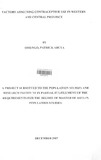| dc.description.abstract | The objectives of this project are to establish the factors that affect contraceptive use in Western
and Central Province. The specific objectives of the project are to identify the socio-economic,
demographic and cultural factors that affect contraceptive use in the regions. A literature review
is carried out to identify a theoretical and conceptual framework. United Nations has proposed a
micro level model; an outgrowth of the microeconomic and demographic theories of Eastern
1975. Contraceptive behavior at the individual level is viewed via a micro-level model of
contraceptive decision making adapted from the socioeconomic theory of fertility.
The study utilizes data from the 1998 Kenya Demographic and health survey carried out by the
National Council for Population and Development (NCPD) in collaboration with the Central
Bureau of statistics (CBS). Our subject population is all women who report to be in union at the
time the survey was conducted. Descriptive statistical methods involve use of frequency
distribution tables and percentages tabulated separately for Central and Western province. Cross
tabulation method for bivariate analysis with chi-square test statistic and the logistic regression
model are applied. In logistic regression the ~estimated coefficients for the independent variables
present the shape or the rate of change of a function of the dependent variable, current
contraceptive use. '
Key results of the study are presented in form of frequency tables and graphs. Our sample
identifies 450 currently married women in Central province compared to 520 currently married
women in Western province. In Central Province (63.6%) of women are current contraceptive
users compared to (30.8%) in Western Province.
As expected, Demographic factors age group, parity, and age at marriage are significantly
associated with contraceptive use in Western province. Socioeconomic factors, place of
residence and type of union significantly affect contraceptive use in Western province. Highest
education level is significant in both Central and Western province. In Central province,
knowledge of methods and perception of husband approval are significantly associated with
contraceptive use. In Western Province exposure to radio and perception of husband approval are
significant.
Number of living children is more strongly associated with contraceptive use In Western
province compared to central province. Secondly, recently married women have a lower
likelihood of using contraceptives. Third polygamy is highly associated with contraceptive use in
Western province. Fourth women who have attained secondary education are more likely to
practice contraception. Fifth women who have heard family planning on radio are more likely to
use contraceptives. Sixth, husband spouse approval significantly explains contraceptive use
differences in Central and Western province.
In Western province women are less likely to use contraceptives since they marry early, desire
more children and are more at risk of a child death during their reproductive period.
Socioeconomic factors like place of residence and educational attainment significantly increase
the probability of a woman in central province using contraceptives. Contraceptive use
differences in Western and Central province are significant. Choice of a family planning policy
requires focus on fertility intentions of women and on family size desires. The existing national
family planning program has been more effective in Central province.
The results of this study recommend three broad policy options. Governments need to reduce the
demand for large families, actually for families of more than three children. It is important to
focus on specific policy issues to reduce unwanted pregnancy by addressing unmet need for
contraception. The government should improve infant and child survival through attention to
primary health care. Third the government should slow down the rate of population growth by
increasing the average age at childbearing. Contraceptive use differentials in Central and
Western province are attributed to differences in association between demographic conditions
and intervening factors, which have a significantly stronger positive effect in Central province. | en |

